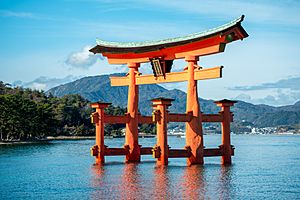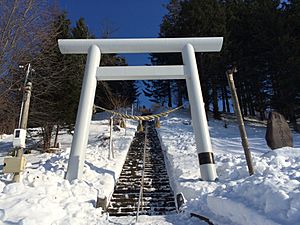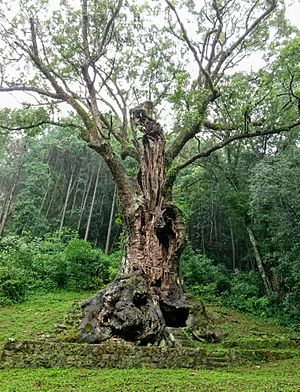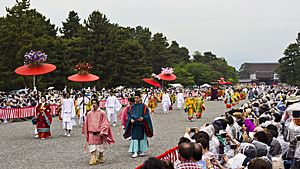Shinto facts for kids

Shinto (pronounced Shin-toh) is a special religion that comes from Japan. It's considered Japan's very own, original religion, and it deeply connects with nature. Shinto is the biggest religion in Japan, with Buddhism being the second largest.
Contents
History of Shinto
Many Shinto traditions and practices have been around in Japan since the 700s. However, some experts believe that Shinto became known as a separate religion much later. This happened in the 1800s, during Japan's Meiji era.
What Shinto Believes
Shinto has many different gods and spirits. People who follow Shinto believe that everything in the world has a soul. This includes nature, like mountains, rivers, and trees.
Important Values in Shinto
Shinto teaches people to value many good qualities. These include being sincere (makoto), honest (tadashii), and working hard (tsui-shin). Giving thanks (kansha) to the kami (spirits) is also very important. Being shojiki means being honest, fair, and truthful.
Shinto also talks about four virtues called akaki kiyoki kokoro. This means having a "pure and cheerful heart."
How Shinto is Practiced
Followers of Shinto believe in supernatural beings called the kami. The word kami usually means "god" or "spirit." The kami are everywhere. They live in all things, including nature's forces and important places in the landscape.
People worship the kami at small shrines in their homes called kamidana. They also visit larger public shrines known as jinja. Priests at public shrines help with offerings of food and drinks. These offerings are given to the specific kami honored at that shrine.
Long ago, people thought the kami were invisible and had no shape. Later, influenced by Buddhism, they started to be shown in human form. Statues of the kami are called shinzo.
The kami can bring good things to a person or cause bad things to happen. To please the kami, people place special objects called go-shintai in shrines. These are often mirrors, swords, stones, beads, or special tablets. They are usually hidden inside boxes. Even priests do not know what they look like. This helps keep peace and balance between the human world and the spirit world.
Other common rituals include kagura dances. There are also special ceremonies for important life events. Seasonal festivals are also a big part of Shinto.
Being pure is very important in Shinto. So, people often wash and bathe in special ways before they worship.
New Year Celebrations
The New Year season is called shogatsu. On the last day of the year, December 31st, called omisoka, people usually clean their home shrines. Many people visit public shrines to celebrate the New Year. This first visit of the year is known as hatsumōde.
At the shrines, people buy special charms and good luck items. These are meant to bring them good fortune for the coming year. To celebrate, many Japanese hang ropes called shimenawa on their homes and businesses. Some also put up kadomatsu. These are arrangements of pine branches, plum trees, and bamboo sticks. Smaller, colorful decorations called kazari are also used. They help keep away bad luck and attract good luck.
Interesting Facts About Shinto
- The word Shinto comes from two Chinese characters. shen (神) means "spirit." dao (道) means "way" or "path." So, Shinto is often translated as "the way of the kami."
- There is no single leader or main organization in charge of Shinto.
- The religion does not have one specific founder or a strict set of rules. It is practiced in many different local ways.
- In Shinto, people believe that the dead can become kami.
- After Japan lost World War II, Shinto was officially separated from the government.
- There are about 100,000 public Shinto shrines in Japan.
- Many Japanese people who follow Shinto also practice Buddhism.
- Public festivals are called matsuri. A common part of these festivals are parades known as gyōretsu.
- Shinto shrines often hold their festival celebrations on "clear days" (hare-no-hi). These are the days of the new, full, and half moons.
See also
 In Spanish: Sintoísmo para niños
In Spanish: Sintoísmo para niños






